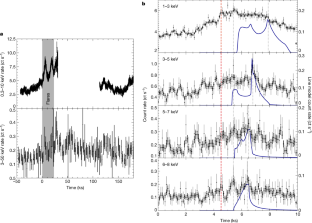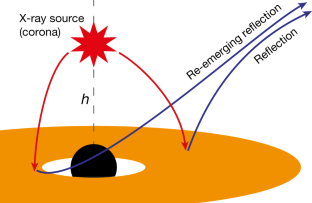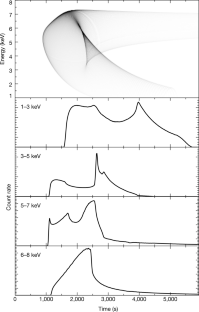Abstract
The innermost regions of accretion disks around black holes are strongly irradiated by X-rays that are emitted from a highly variable, compact corona, in the immediate vicinity of the black hole1,2,3. The X-rays that are seen reflected from the disk4, and the time delays, as variations in the X-ray emission echo or ‘reverberate’ off the disk5,6, provide a view of the environment just outside the event horizon. I Zwicky 1 (I Zw 1) is a nearby narrow-line Seyfert 1 galaxy7,8. Previous studies of the reverberation of X-rays from its accretion disk revealed that the corona is composed of two components: an extended, slowly varying component extending over the surface of the inner accretion disk, and a collimated core, with luminosity fluctuations propagating upwards from its base, which dominates the more rapid variability9,10. Here we report observations of X-ray flares emitted from around the supermassive black hole in I Zw 1. X-ray reflection from the accretion disk is detected through a relativistically broadened iron K line and Compton hump in the X-ray emission spectrum. Analysis of the X-ray flares reveals short flashes of photons consistent with the re-emergence of emission from behind the black hole. The energy shifts of these photons identify their origins from different parts of the disk11,12. These are photons that reverberate off the far side of the disk, and are bent around the black hole and magnified by the strong gravitational field. Observing photons bent around the black hole confirms a key prediction of general relativity.
Access options
Subscribe to Journal
Get full journal access for 1 year
199,00 €
only 3,90 € per issue
Tax calculation will be finalised during checkout.
Rent or Buy article
Get time limited or full article access on ReadCube.
from$8.99
All prices are NET prices.




Data availability
The data used in this study from NuSTAR and XMM-Newton are publicly available. NuSTAR observations can be accessed via the NASA High Energy Astrophysics Science Archive Research Center (https://heasarc.gsfc.nasa.gov). This work includes data obtained during NuSTAR observation ID 60501030002. XMM-Newton observations can be accessed via the XMM-Newton Science Archive (http://nxsa.esac.esa.int/nxsa-web). The primary analysis was conducted on observation IDs 0851990101 and 0851990201. Observation IDs 0110890301, 0300470101, 0743050301 and 0743050801 were included in the measurement of the average reverberation timescale.
Code availability
X-ray spectroscopic analysis was conducted using xspec, which is freely available as part of the Heasoft package (https://heasarc.gsfc.nasa.gov/docs/software/heasoft). The emcee MCMC sampling code is available is available at http://emcee.readthedocs.io, and the X-spec implementation by J. Sanders is available at https://github.com/jeremysanders/xspec_emcee. The relxill X-ray reflection model is available at https://ift.tt/3j1wN6e. Analysis of light curves and X-ray reverberation was conducted using pyLag, publicly available at https://github.com/wilkinsdr/pyLag. The CUDAKerr code used for reverberation modelling is available on request from the corresponding author.
References
- 1.
Galeev, A. A., Rosner, R. & Vaiana, G. S. Structured coronae of accretion disks. Astrophys. J. 229, 318–326 (1979).
- 2.
Haardt, F. & Maraschi, L. A two-phase model for the X-ray emission from Seyfert galaxies. Astrophys. J. Lett. 380, L51 (1991).
- 3.
Merloni, A. & Fabian, A. C. Thunderclouds and accretion discs: a model for the spectral and temporal variability of Seyfert 1 galaxies. Mon. Not. R. Astron. Soc. 328, 958–968 (2001).
- 4.
George, I. M. & Fabian, A. C. X-ray reflection from cold matter in active galactic nuclei and X-ray binaries. Mon. Not. R. Astron. Soc. 249, 352–367 (1991).
- 5.
Uttley, P., Cackett, E. M., Fabian, A. C., Kara, E. & Wilkins, D. R. X-ray reverberation around accreting black holes. Astron. Astrophys. Rev. 22, 72 (2014).
- 6.
Fabian, A. C. et al. Broad line emission from iron K- and L-shell transitions in the active galaxy 1H0707–495. Nature 459, 540–542 (2009).
- 7.
Boller, T., Brandt, W. N. & Fink, H. Soft X-ray properties of narrow-line Seyfert 1 galaxies. Astron. Astrophys. 305, 53 (1996).
- 8.
Gallo, L. C. Investigating the nature of narrow-line Seyfert 1 galaxies with high-energy spectral complexity. Mon. Not. R. Astron. Soc. 368, 479–486 (2006).
- 9.
Wilkins, D. R. et al. Revealing structure and evolution within the corona of the Seyfert galaxy I Zw 1. Mon. Not. R. Astron. Soc. 471, 4436–4451 (2017).
- 10.
Gallo, L. C., Brandt, W. N., Costantini, E. & Fabian, A. C. A longer XMM-Newton look at I Zwicky 1—distinct modes of X-ray spectral variability. Mon. Not. R. Astron. Soc. 377, 1375–1382 (2007).
- 11.
Reynolds, C. S., Young, A. J., Begelman, M. C. & Fabian, A. C. X-ray iron line reverberation from black hole accretion disks. Astrophys. J. 514, 164–179 (1999).
- 12.
Wilkins, D. R., Cackett, E. M., Fabian, A. C. & Reynolds, C. S. Towards modelling X-ray reverberation in AGN: piecing together the extended corona. Mon. Not. R. Astron. Soc. 458, 200–225 (2016).
- 13.
Harrison, F. A. et al. The Nuclear Spectroscopic Telescope Array (NuSTAR) high-energy X-ray mission. Astrophys. J. 770, 103 (2013).
- 14.
Jansen, F. et al. XMM-Newton observatory. I. The spacecraft and operations. Astron. Astrophys. 365, L1–L6 (2001).
- 15.
Risaliti, G. et al. A rapidly spinning supermassive black hole at the centre of NGC 1365. Nature 494, 449–451 (2013).
- 16.
Fabian, A. C., Rees, M. J., Stella, L. & White, N. E. X-ray fluorescence from the inner disc in Cygnus X-1. Mon. Not. R. Astron. Soc. 238, 729–736 (1989).
- 17.
Wilkins, D. R. et al. Flaring from the supermassive black hole in Mrk 335 studied with Swift and NuSTAR. Mon. Not. R. Astron. Soc. 454, 4440–4451 (2015).
- 18.
Strüder, L. et al. The European photon imaging camera on XMM-Newton: the pn-CCD camera. Astron. Astrophys. 365, L18–L26 (2001).
- 19.
Dauser, T. et al. Normalizing a relativistic model of X-ray reflection. Definition of the reflection fraction and its implementation in relxill. Astron. Astrophys. 590, A76 (2016).
- 20.
García, J. & Kallman, T. R. X-ray reflected spectra from accretion disk models. I. Constant density atmospheres. Astrophys. J. 718, 695–706 (2010).
- 21.
García, J., Kallman, T. R. & Mushotzky, R. F. X-ray reflected spectra from accretion disk models. II. Diagnostic tools for X-ray observations. Astrophys. J. 731, 131 (2011).
- 22.
García, J. et al. X-Ray reflected spectra from accretion disk models. III. A complete grid of ionized reflection calculations. Astrophys. J. 768, 146 (2013).
- 23.
Dauser, T., Wilms, J., Reynolds, C. S. & Brenneman, L. W. Broad emission lines for a negatively spinning black hole. Mon. Not. R. Astron. Soc. 409, 1534–1540 (2010).
- 24.
Silva, C. V. et al. The variability of the warm absorber in I Zwicky 1 as seen by XMM-Newton. Mon. Not. R. Astron. Soc. 480, 2334–2342 (2018).
- 25.
Costantini, E., Gallo, L. C., Brandt, W. N., Fabian, A. C. & Boller, T. A longer XMM-Newton look at I Zwicky 1: physical conditions and variability of the ionized absorbers. Mon. Not. R. Astron. Soc. 378, 873–880 (2007).
- 26.
García, J. A. et al. The effects of high density on the X-ray spectrum reflected from accretion discs around black holes. Mon. Not. R. Astron. Soc. 462, 751–760 (2016).
- 27.
Done, C., Davis, S. W., Jin, C., Blaes, O. & Ward, M. Intrinsic disc emission and the soft X-ray excess in active galactic nuclei. Mon. Not. R. Astron. Soc. 420, 1848–1860 (2012).
- 28.
Wilkins, D. R. & Fabian, A. C. Understanding X-ray reflection emissivity profiles in AGN: locating the X-ray source. Mon. Not. R. Astron. Soc. 424, 1284–1296 (2012).
- 29.
Wilkins, D. R. & Fabian, A. C. The origin of the lag spectra observed in AGN: reverberation and the propagation of X-ray source fluctuations. Mon. Not. R. Astron. Soc. 430, 247–258 (2013).
- 30.
Press, W. H. & Schechter, P. Remark on the statistical significance of flares in Poisson count data. Astrophys. J. 193, 437–442 (1974).
- 31.
Emmanoulopoulos, D., McHardy, I. M. & Papadakis, I. E. Generating artificial light curves: revisited and updated. Mon. Not. R. Astron. Soc. 433, 907–927 (2013).
- 32.
Iwasawa, K., Miniutti, G. & Fabian, A. C. Flux and energy modulation of redshifted iron emission in NGC 3516: implications for the black hole mass. Mon. Not. R. Astron. Soc. 355, 1073–1079 (2004).
- 33.
Narayan, R. & Quataert, E. Black hole accretion. Science 307, 77 (2005).
- 34.
Huang, Y.-K. et al. Reverberation mapping of the narrow-line Seyfert 1 galaxy I Zwicky 1: black hole mass. Astrophys. J. 876, 102 (2019).
- 35.
Vestergaard, M. & Peterson, B. M. Determining central black hole masses in distant active galaxies and quasars. II. Improved optical and UV scaling relationships. Astrophys. J. 641, 689–709 (2006).
- 36.
Collin, S., Kawaguchi, T., Peterson, B. M. & Vestergaard, M. Systematic effects in measurement of black hole masses by emission-line reverberation of active galactic nuclei: Eddington ratio and inclination. Astron. Astrophys. 456, 75–90 (2006).
Acknowledgements
This work was supported by the NASA NuSTAR and XMM-Newton Guest Observer programmes under grants 80NSSC20K0041 and 80NSSC20K0838. D.R.W. received additional support from a Kavli Fellowship at Stanford University. W.N.B. acknowledges support from the V. M. Willaman Endowment. Computing for this project was performed on the Sherlock cluster. D.R.W. thanks Stanford University and the Stanford Research Computing Center for providing computational resources and support.
Author information
Affiliations
Contributions
D.R.W. performed the data analysis and reverberation modelling. L.C.G. contributed to the analysis of the XMM-Newton spectra. W.N.B., E.C. and R.D.B. contributed to the interpretation and discussion of the results.
Corresponding author
Ethics declarations
Competing interests
The authors declare no competing interests.
Additional information
Peer review information Nature thanks the anonymous reviewers for their contribution to the peer review of this work. Peer reviewer reports are available.
Publisher’s note Springer Nature remains neutral with regard to jurisdictional claims in published maps and institutional affiliations.
Extended data figures and tables
Extended Data Fig. 1 The X-ray spectrum of I Zw 1.
a, The soft and hard X-ray spectra of I Zw 1 obtained by XMM-Newton and NuSTAR during the 2020 observations, fitted with a model describing the emission in the 3–50-keV band as the combination of directly observed continuum emission and its reflection from the disk, described by relxill. b, Ratio of the X-ray spectrum in the 3–78-keV energy range measured with NuSTAR to the best-fitting power-law continuum model, showing the residual features that arise because of the X-rays reflected from the inner accretion disk: the broad iron K line (around 6.4 keV) with redshifted wing, and the Compton hump centred at 25 keV. Error bars represent 1σ uncertainties due to Poisson noise.
Extended Data Fig. 2 The relative response times of the X-ray emission at different energies to variations in luminosity.
The time lag is computed from the cross-spectrum, averaged over Fourier frequency components from 5× 10−4 to 7 × 10−4 Hz from all XMM-Newton observations of I Zw 1 between 2002 and 2020. The lag versus energy spectrum shows the delay of the response of the iron K line and soft X-ray excess, which reverberate from the accretion disk, with respect to the continuum, which is most dominant in the 1–2-keV energy band. Error bars show the 1σ confidence interval.
Extended Data Fig. 3 Detection of short peaks in the X-ray light curves.
a, The raw light curves obtained from the XMM-Newton EPIC pn camera in the 3–5-keV, 5–7-keV and 6–8-keV energy bands, in 100-s time bins. The blue line shows the smoothed light-curve model with respect to which the significance of short peaks is assessed. The panel beneath each light curve shows the reduction in the χ2 statistic over this model, when a short Gaussian peak is added in different time bins with different normalization. Shaded regions correspond to 1σ (blue), 2σ (yellow) and 3σ (red) detections. The bottom panel shows the maximum reduction in χ2 when a flare is added in each time bin. The peaks of interest that are offset between the bands appear at 6.8 ks and 18.8 ks. b, The same, with light curves in each energy band summed between the first and second flare, aligning the 3–5-keV peaks at 6.8 ks and 18.8 ks.
Extended Data Fig. 4 The coherence between the 3–5-keV and 1–3-keV light curves.
The coherence describes the fraction of the variability in each light curve, at different Fourier frequencies, that can be predicted based on a linear transformation (for example the reverberation response) of the variability in the other light curve. The observed coherence is compared with predictions of pairs of random, red noise light curves between which a fraction u of variability is uncorrelated. Much of the drop in coherence at high frequencies is due to Poisson noise, and the high values of the coherence measured at low frequencies set tight constraints on the level of uncorrelated variability that can exist between the light curves that is not due to Poisson noise.
Supplementary information
Supplementary Information
This file contains alternative explanations for the short-timescale variability and notes regarding the mass of the black hole.
Rights and permissions
About this article
Cite this article
Wilkins, D.R., Gallo, L.C., Costantini, E. et al. Light bending and X-ray echoes from behind a supermassive black hole. Nature 595, 657–660 (2021). https://ift.tt/3zKkhPf
-
Received:
-
Accepted:
-
Published:
-
Issue Date:
Comments
By submitting a comment you agree to abide by our Terms and Community Guidelines. If you find something abusive or that does not comply with our terms or guidelines please flag it as inappropriate.
"light" - Google News
July 28, 2021 at 10:26PM
https://ift.tt/3f2KKzW
Light bending and X-ray echoes from behind a supermassive black hole - Nature.com
"light" - Google News
https://ift.tt/2Wm8QLw
https://ift.tt/2Stbv5k
Bagikan Berita Ini














0 Response to "Light bending and X-ray echoes from behind a supermassive black hole - Nature.com"
Post a Comment